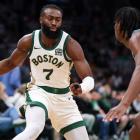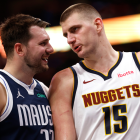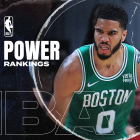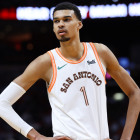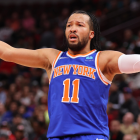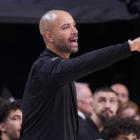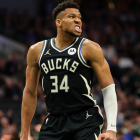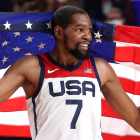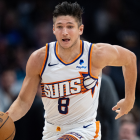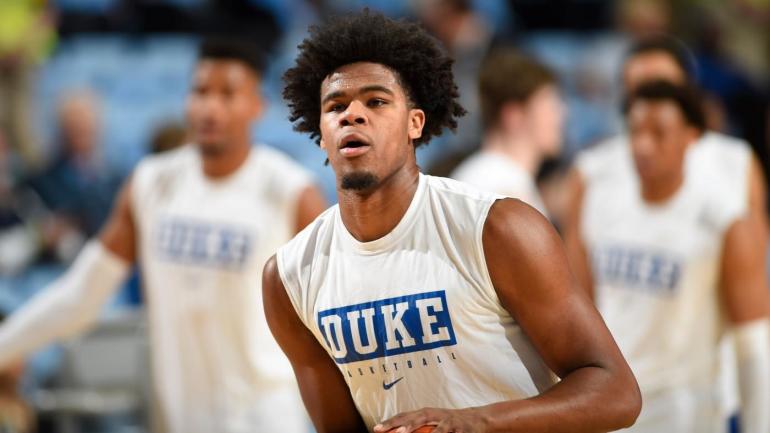
In a normal year the gap between the end of the NCAA Tournament and the NBA Draft is approximately 85 days.
If the 2020 Draft goes as scheduled Oct. 16, college players will have waited more than 215 days between their last game and hearing their name called that Friday night.
When factoring in underclassmen and outgoing seniors, more than 200 draft hopefuls (plenty of whom will announce they're headed back to college later this month) have spent the past 14-plus weeks in unrivaled pre-draft limbo. Left to their own devices, and restricted for the most part by COVID-19 regulations, some players have living and training situations superior to others. NBA teams have not been allowed to work players out or do anything beyond being permitted a few hours per prospect to interview via teleconference.
That's left inevitable draftees, and borderline-pick hopefuls, spinning in place all over the country.
"There's supreme confidence and belief in myself and in my game," former Marquette star Markus Howard said. "In this process, I just know all it takes is one team. I'm not sitting here thinking all 32 teams are going to love me. I'm realistic."
CBS Sports checked in with Howard from his family home in Chandler, Arizona, on June 25 -- what would have been the day of the draft had it not been postponed. Howard's been home all but three days since mid-March. The one break in his schedule came in the middle of April when he flew back to Milwaukee to lonesomely clean out his things and pack up what he couldn't take before. In mid-March Howard flew home within 48 hours of the cancellation of the Big East Tournament.
Itching for more college hoops analysis? Listen below and subscribe to the Eye on College Basketball podcast where we take you beyond the hardwood with insider information and instant reactions.
Howard's a fascinating prospect. He led the nation in scoring his senior season (27.8 ppg) and finished his career with 2,761 points. Had the season ended as expected, Howard would have easily cracked 2,800, becoming the 20th men's player in history to pull off the feat. As a junior, he was a second team All-American. This past season he was a no-doubt-about-it first team selectee.
Howard fits the definition of Great College Basketball Player.
Yet his draft stock is impossible to pin down.
He unequivocally believes he's a first-round talent. Whether that means anything to any NBA front office at this point is anyone's guess. Due to his size and height (5-foot-11, 178 pounds) and defensive shortcomings, Howard is not a sure thing -- as of today -- to be picked in October.
"That's not something I'm going to worry about and lose sleep over at night because that's out of my control," he said. "I just know whenever the time does present itself, I know I'm going to represent myself as best I can. If what I did in college doesn't make people look and see me as a definite prospect then I don't know what to say. People have always doubted me from the beginning, ever since I got to college with my size, and my thing is: Who's going to continue make the same mistake over and over again? I was doubted in high school, doubted in college all over again. If people overlook me again I'm going to have to prove them wrong, but you would think people would learn sooner or later."
Interview tactics differ by player -- and agent
Howard's interviewed with 26 teams -- Orlando, Milwaukee and Golden State being some of his standouts -- but tossing a wide net is not an every-prospect approach.
Vernon Carey Jr. was almost as good as Howard last season. Carey starred at Duke, was a second team All-American and was national Freshman of the Year. Like Howard, Carey is projected lower than his college value and production suggest he should be. Unlike Howard, he's not interviewing with almost every franchise.
Nearly four months into quarantine, Carey is yet to talk with a single team.
The reason for this is Carey's representatives see little benefit to him fielding calls for now, not with an information drought regarding if or when any kind of quasi-combine will be held. Short of that, will teams eventually be able to travel to South Florida and see Carey work out or interview in person? No one knows the answers to those questions. In speaking with multiple player agents on background for this story, their feeling is NBA teams are largely focused on the restart to the season in Orlando, and that general managers won't get serious about draft tasks until mid-August at the earliest.
Carey said his most recent weigh-in brought him down to 247 pounds. Combine that with his 6-9 frame and fluctuating label between power forward and center, he'll be drafted as a big-man project. Carey was ranked sixth in his high school class (2019) and only expanded his repertoire while playing 31 games at Duke.
"I feel like the season that I had, I was supposed to," Carey said.
He surpassed expectations and was objectively one of the five most dominant freshmen Mike Krzyzewski's ever coached. Carey averaged 17.8 points, 8.8 rebounds and was the seventh most valuable player in the sport, according to KenPom.com's calculations. (Howard was third.)
In my big-board mock draft, I have Carey going 17th. Others aren't as optimistic.
"Seeing the mock drafts just gives me motivation to keep on working and just keep on improving," he said.
Whereas Carey waits for the interview circuit, Howard and former LSU star guard Skylar Mays are done with initial rounds. Mays hasn't talked with any teams in a month-plus but nonetheless has spoken with every franchise except three: the Heat, Lakers and Mavericks. Mays isn't like Carey or Howard. He was one of the better players in the SEC, but his stats (16.7 ppg, 5.0 rpg, 3.2 apg) and accolades didn't make room for him to be talked about on an every-week basis during the season the way Howard and Carey were.
But Mays figures to be one of the smartest players in this year's draft pool, so it makes sense to show off his potential to as many teams as possible.
"I have no idea what my true draft range is," Mays said. "I don't really ask questions like that to [my agent] to be honest. I'm sure that was part of their mindset, that it wouldn't hurt to talk to teams, especially them knowing the type of person I am and how comfortable I am in my skin. I definitely wouldn't hurt myself in an interview."
Mays said the interviews are mostly structured the same and that he hasn't received one off-the-wall or "wild' question -- those strange tactics we hear about annually before the NFL Draft. Mays estimated his interviews on average are 30% background information, 40% about mental makeup and another 30% is strictly tied to basketball-type things. Howard's experience has been that teams are split into two approaches: rigidly structured with prepared questions and not much space for digression, or an informal, free-flowing, conversation-based method.
"They get really in depth," Mays said. "They want to see if you know the game. Some teams have asked me to draw a game-ending play, things like that. They showed me my old plays and told me what to see, what my thought process was there, so it's been really cool. It's really fun. I've learned a lot through it too."
Training and living
Mays, who is 6-4, 205 pounds, lived in his one-bedroom on-campus LSU apartment until the end of May thanks to a lease he finished out. He's been at his home just over month. The change, well, it's drastic. Mays went from living by himself in his final two months as a college senior to sharing a house with his seven siblings and parents. Ten Mayses under one roof. He shares a room with an older brother. Mays is the third oldest of eight siblings, all between 15 and 25 years old.
When Mays was in his apartment, on LSU's campus, at least he had a little access to train and keep fit, right?
"No, not even close," he said. "LSU was shut down. It's still shut down as far as I know. I haven't been to our practice gym or anything like that for quite some time. From mid-March to April I hardly touched the ball and then things started to open up a little bit."
Mays' family home is 10 minutes from LSU's campus, so he's been able to train and work out in an extra-cautious way with a few people he knows who have access to gyms and weight rooms around Baton Rouge. Initially, Louisiana was one of the hardest hit states by the coronavirus, trailing only behind New York and New Jersey. Jonathan Pixley, a 2,000-point scorer at Samford in the 1990s, has been training Mays, who has been staying sharp the past six weeks thanks to getting two-a-days in with Vanderbilt sophomore Jordan Wright.
For the first three weeks of quarantine, Mays filled up his days with schoolwork and hardly any exercise (maybe some basic stuff in his apartment), doing so intentionally because he didn't know how long the pandemic would halt life in Louisiana.
"I'm not a guy who likes to spend too much time off, but just taking advantage after going through four years at LSU and all those games, just reflecting and kind of enjoying being a student as best as I can," Mays said. "Even though it's a weird, weird time, I really tried to get away from the game for a little bit. I think it was really beneficial for me."
Howard's done the opposite. His training situation might be better than any other prospect's in this draft. Howard's father has made a living in the strength-and-conditioning space for decades. His brother, Jordan, was a standout player at Central Arkansas. The gym he uses daily is the one his dad works out of.
"It's one that we're very fortunate to have," he said. "I'm in the gym all the time."
The family has taken to posting their workout regimens to YouTube. It's certainly a beneficial way to help Howard get his prep out to teams that might be wanting to see a bit more at this stage. Prospects and their representatives are not allowed to directly send any video to teams at this stage.
In Fort Lauderdale, Florida, Carey has fluctuated his training based on what has and hasn't been happening with teams, who have let it be known to Carey, through his agent or college coaches, that lateral quickness and him being able to guard ball-screen defense is a priority.
"In the beginning of the month I thought we were going to have a team workout, so we were ramping it up with our training, like five times a week," Carey said.
Those would still include two-a-days at his high school gym, NSU University School, and carving up with his trainer who he's been with for years. Then Florida's coronavirus positives started spiking in June.
"We cut it down a little bit and are working out three to four times a week," Carey said. "My conditioning has gotten way better. And just my lateral quickness. My overall movement has gotten better. I feel like that's mainly what I've been working on these last two to three months."
Waiting is the hardest part
July will be more of the same grind-and-wait. Howard, Carey, Mays and every other future draft pick/hopeful will have to keep to a discipline and continue to stave off quarantine boredom by committing to training. No real movement on draft intel is coming until August at the earliest.
For a player like Carey, it's impossible to know if this will ultimately prove to be a good thing. The further we get away from his dynamite season, are more teams more likely to be suspect because of his position? Carey says his Duke season saved his draft stock because injury prevented him from playing in high-profile all-star high school events such as the Jordan Brand Classic and the McDonald's All-American game.
Teams also want to see more of his shot, to show he does have some consistent extended range. There's an eagerness and helplessness at this stage. It's ironic to see the best freshman in college basketball is still being sold short. Carey said his versatility isn't given enough credence, or that hasn't been expressed to him yet.
"Me being able to just put the ball on the floor and do other things and being in the post I mean, I just feel like I'm more versatile than I show, than what they see me as," he said.
As for Mays, he feels like he's the best guard in the draft but he's also pragmatic. He'll be 23 by the time the draft arrives, and that could play a part in if he's picked at all.
"I think I'm a much better basketball player than I'm given credit for," he said. "I've done a lot in academics and maybe that overshadows what I've done on the court sometimes, but I have a genuine love for the game and I really take my craft seriously and I come to work every day and want to be the best player I can be and want to have a Hall of Fame career in the NBA as a player."
If it was as simple as relying on tape and trusting the eyes of your scouting department, the draft would be a much more streamlined operation and this waiting game wouldn't much matter. So much more goes into it, though, and how prospects handle their business from March through October in itself becomes a determining factor. If there's no combine, college performance could have more influence over who's picked in what order than any draft in decades. For Mays, Howard and Carey, that can only be a great thing.














